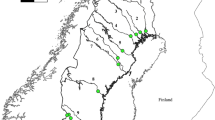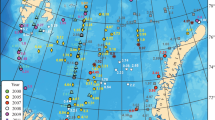Abstract
The rivers in the Baltic Basin drain a mixture of bedrocks ranging from Mesozoic-Paleozoic sediments in the south to Proterozoic-Archean intrusives in the north. The rivers in the sedimentary basin in the south have high concentrations of Sr, in the interval 100–500 µg l−1 while the87Sr/86Sr ratio is close to that of seawater, i.e. 0.71. The northern rivers in the Precambrian shield area on the other hand have low Sr concentrations of 15–50 µg l−1 with high87Sr/86Sr ratios of about to 0.73 (0.721–0.745). The riverine input of dissolved Sr to the brackish Baltic Sea approaches 60 tons year−1, with a weighted mean concentration approaching 130 µg l−1 and a weighted mean87Sr/86Sr ratio close to 0.712. Although the sedimentary area in the south supplies only about 43% of the total river discharge, it gives about 88% of the total Sr input. Because of this and the strong regional riverine variation in87Sr/86Sr ratio, Sr and its isotopes seem to be a convenient tool to unveil mixing relations of water masses in the northern Baltic Sea, provided high resolution analyses are applied. For an overall characterization of water mixing in the Baltic Sea, the Nd system will be superior to that of Sr.
Similar content being viewed by others
References
Åberg, G., and F. E. Wickman, 1987. Variations of87Sr/86Sr in water from streams discharging into the Bothnian Bay, Baltic Sea. Nord. Hydrol. 18:21–32.
Åberg, G., G. Jacks and P. J. Hamilton, 1989. Weathering rates and87Sr/86Sr ratios: an isotopic approach. J. Hydrol. 109:65–78.
Åberg, G., G. Jacks, T. Wickman and P. J. Hamilton, 1990. Strontium isotopes in trees as an indicator for calcium availability. Catena 17:1–11.
Andersson, P., R. Löfvendahl and G. Åberg, 1990. Major element chemistry,∂ 2H,∂ 18O and87Sr/86Sr in a snow profile across central Scandinavia. In press, Atmos. Environ. 24A.
Bastin, R., and G. Faure, 1970. Seasonal variation of the solute content and the87Sr/86Sr ratio of the Olentangy and Scioto Rivers at Columbus, Ohio. Ohio J. Sci. 70:170–179.
Baumgartner, A., and E. Reichel, 1976. The world water balance. Elsevier, Amsterdam, 179 pp.
Biscaye, P. E., R. Chesselet and J. M. Prospero, 1974. Rb/Sr,87Sr/86Sr isotope system as an index of provenance of continental dusts in open Atlantic Ocean. J. Recherch. Atmos. 8:819–829.
Boström, K., B. Boström and P. Andersson, 1989. Natural and Anthropogenic Components in Bulk Precipitation at Blidö (Archipelago of Stockholm). Water Resour. Res. 25:1291–1301.
Brandt, M., 1982–87. Sediment transport in Swedish rivers 1980–83 (In Swedish). Mimeographed Reports. Swed. Meteorol. Hydrol. Inst. (SMHI). Norrköping.
Burman, J.-O., B. Boström and K. Boström, 1977. Geochemical analyses by plasma spectroscopy. Geol. Fören. Stockh. Förh. 99:102–110.
DePaolo, D. J., and B. L. Ingram, 1985. High-resolution stratigraphy with strontium isotopes. Science 227:938–941.
Ehlin, U., 1981. Hydrology of the Baltic Sea. In: A. Voipio (ed.), The Baltic Sea, Elsevier Oceanography Series 30, Amsterdam, pp. 123–134.
Faure, G., 1986. Principles of Isotope Geology, 2nd ed. John Wiley and Sons, N. Y., 589 pp.
Faure, G., J. H. Crocket and P. M. Hurley, 1967. Some aspects of the geochemistry of strontium and calcium in the Hudson Bay and the Great Lakes. Geochim. Cosmochim. Acta 31:451–461.
Fonselius, S., 1984. Långtidsvariationer ì salthalten ì Östersjöns djupvatten. Medd. Sven. Havsforskningsfören. 19:131–146.
Förstner, U., and G.T.W. Wittman, 1981. Metal pollution in the Aquatic Environment. 2nd ed. Springer Verlag, Berlin, 486 pp.
Goldstein, S. J., and S. R. Jacobsen, 1987. The Nd and Sr isotopic systematics of river-water dissolved material: implications for the sources of Nd and Sr in seawater. Chem. Geol./Isot. Geosci. 66:245–272.
Grashoff, K., and A. Voipio, 1981. Chemical Oceanography. In: A. Voipio (ed.), The Baltic Sea, Elsevier Oceanography Series 30, Amsterdam, pp. 183–218.
Graustein, W. C., 1989.87Sr/86Sr ratio measure the sources and flow of strontium in terrestrial ecosystems. In: P. W. Rundel, J. R. Ehleringer and K. A. Nagy (eds.), Stable isotopes in ecological research 68, Ecological Studies, Springer, N. Y., pp. 491–512.
Heier, K. S., and G. K. Billings, 1978. Rubidium abundance in rock-forming minerals. In: K. H. Wedepohl (ed.), Handbook of Geochemistry II/4, Springer Verlag, Berlin, pp. 37-D, 1-4.
Jacks, G., G. Åberg and P. J. Hamilton, 1989. Calcium budgets for catchments as interpreted by strontium isotopes. Nord. Hydrol. 20:85–96.
Ku, T.-L., K. G. Knauss and G. G. Mathieu, 1977. Uranium in open ocean: concentration and isotopic composition. Deep-Sea Res. 24:1005–1017.
Löfvendahl, R., 1987. Dissolved uranium in the Baltic Sea. Mar. Chem. 21:213–227.
Löfvendahl, R., 1990. Changes in the flux of some major dissolved components in Swedish rivers during the present century. Ambio 19:210–219.
Löfvendahl, R. Manuscript. Dissolved and particulate uranium, particulate thorium and their nuclides in rivers discharging into the Baltic Sea.
Martin, J.-M., and M. Whitfield, 1983. The significance of the river input of chemical elements to the ocean. In: C. S. Wong, E. Boyle, K. W. Bruland, J. D. Burton and E. D. Goldberg (eds.), Trace metals in sea water. NATO Conf. Series IV: Marine Sciences 9, Plenum Press, pp. 265–296.
Meybeck, M., 1988. How to establish and use world budgets of riverine material. In: A. Lerman and M. Meybeck (eds.), Physical and Chemical weathering in Geochemical Cycles. NATO ASI series: Series C: Mathematical and Physical Sciences 251:247–272.
Mikulski, Z., 1970. Inflow of river water to the Baltic Sea in the period 1951–60. Nord. Hydrol. 4:216–227.
Paces, T., 1982. Natural and anthropogenic flux of major elements from central Europe. Ambio 11:206–208.
Pacyna, J., 1985. Atmospheric trace elements from natural and anthropogenic sources. In: J. O. Nriagu and C. I. Davidson (eds.), Toxic metals in the atmosphere 17. Advances in environmental sciences and technology, John Wiley and Sons, N. Y., pp. 33–52.
Palmer, M. R., and J. M. Edmond, 1989. The strontium isotope budget of the modern ocean. Earth Planet. Sci. Lett. 92:11–26.
Piepgras, D.J., and G. J. Wasserburg, 1980. Neodymium isotopic variations in seawater. Earth Planet. Sci. Lett. 50:128–138.
Skakalsky, B. G., 1984. Study of anthropogenic influence on water quality in some rivers of the Baltic Sea Basin. In: E. Eriksson (ed.), Hydrochemical balances of freshwater systems, IAHS publ. 150:295–302.
Smalley, P. C., R. Blomqvist and A. Råheim, 1988. Sr isotope evidence for discrete saline components in stratified ground waters from crystalline bedrock, Outukumpu, Finland, Geology 16:354–357.
Straughan, I. R., A. A. Elseewi, A. L. Page, I. R. Kaplan, R. W. Hurst and T. E. Davies, 1981. Fly ash-derived strontium as an index to monitor deposition of coal-fired power plants. Science 212:1267–1269.
Stueber, A. M., 1978. Strontium. Abundance in rock-forming minerals. In: K. H. Wedepohl (ed.), Handbook of Geochemistry II/4, Springer Verlag, Berlin, pp. 38-D, 1-17.
Stueber, A. M., A. D. Baldwin, J. B. Curtis jr., P. Pushkar and J. D. Steele, 1975. Geochemistry of strontium in the Scioto River drainage basin. Ohio. Bull. Geol. Soc. Am. 86:892–896.
Veizer, J., 1989. Strontium isotopes in seawater through time. Annual Rev. Earth Planet. Sci. 17:141–167.
Wadleigh, M. A., J. Veizer and C. Brooks, 1985. Strontium and its isotopes in Canadian rivers: Fluxes and global implications. Geochim. Cosmochim. Acta 49:1727–1736.
Wickman, F. E., and G. Åberg, 1987. Variations in the87Sr/86Sr ratio in lake waters from central Sweden. Nord. Hydrol. 18:33–42.
Author information
Authors and Affiliations
Rights and permissions
About this article
Cite this article
Löfvendahl, R., Åberg, G. & Hamilton, P.J. Strontium in rivers of the Baltic Basin. Aquatic Science 52, 315–329 (1990). https://doi.org/10.1007/BF00879760
Received:
Accepted:
Issue Date:
DOI: https://doi.org/10.1007/BF00879760




